DMM Vici VC8145
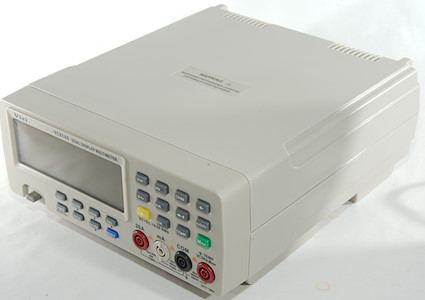
This is a fairly cheap bench DMM from a Chinese manufacturer.
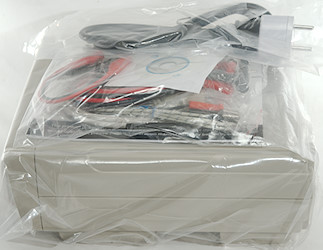
No nice box for the meter was included, probably to save shipping cost (I bought in on Aliexpress).

It included the DMM, a pair of probes, short leads with alligator clips, a thermocoupler, a usb cable, a mains cable with plug converter, a manual, a screwdriver and a CD.


The probe is marked CAT III 1000V, but do not have tip covers, i.e. the marking is not correct. The meter is only for CAT II and do not need CAT III probes.
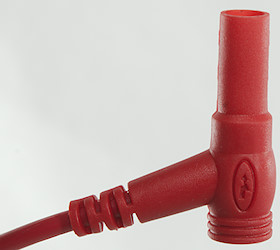
The plug is fully shrouded with short shroud.


The thermocoupler is a standard cheap one.
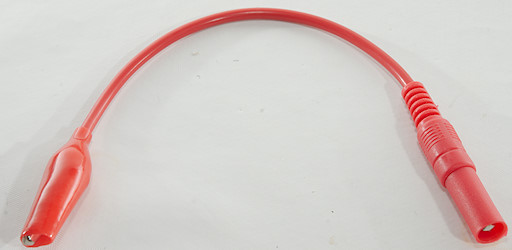


The short leads with alligator clips is nice for component testing.
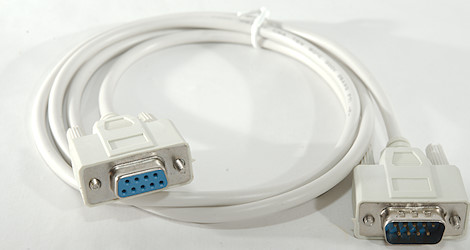
RS232 serial cable, do anybody use these cables anymore?
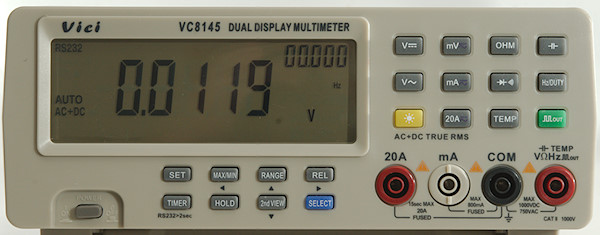
This meter uses buttons to select function, but it only have the regular 4 input sockets (Some bench meters have 6).
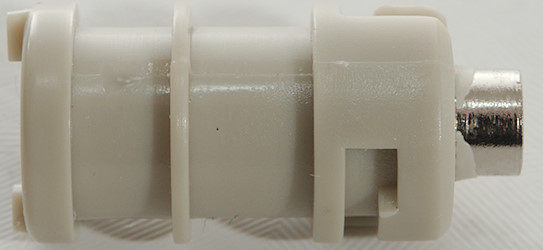
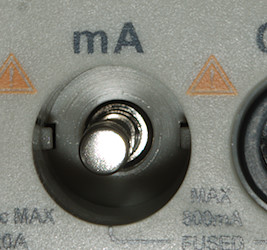
The mA fuse is hidden behind the mA socket. It do not follow with the removeable part out.
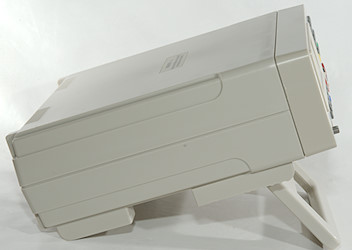
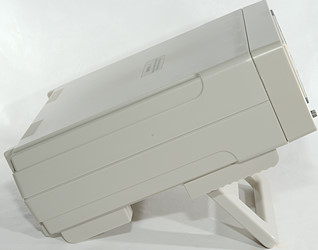
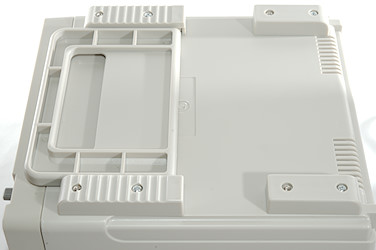
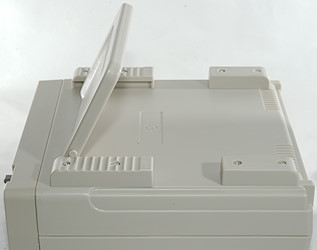
The meter has a build in stand that can tilt it a bit.
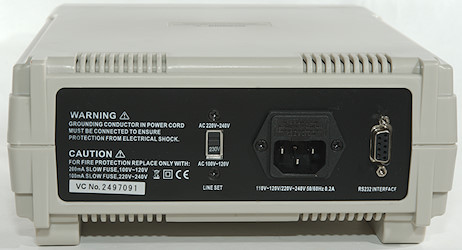
On the back is mains connection with voltage adjustment and RS232 connection.
Display
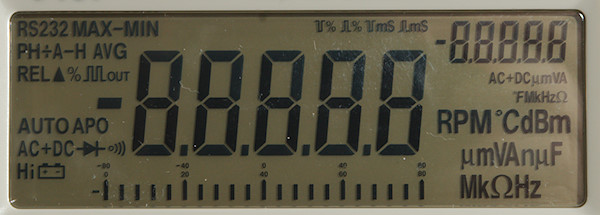
The above picture shows all the segments on the display.
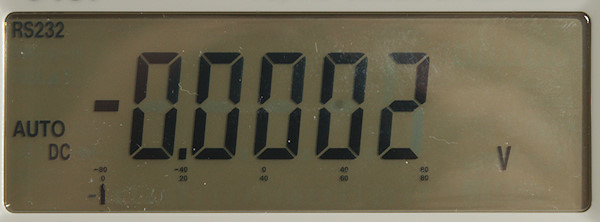
Typical display during usage, it will show the number and what measurement is selected.
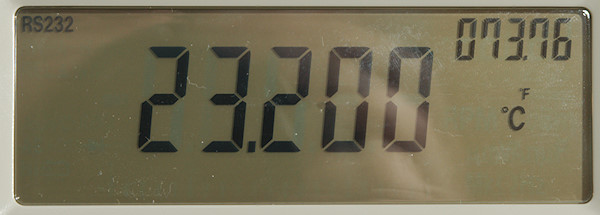
In temperature mode it will show temperature in Celsius and Fahrenheit
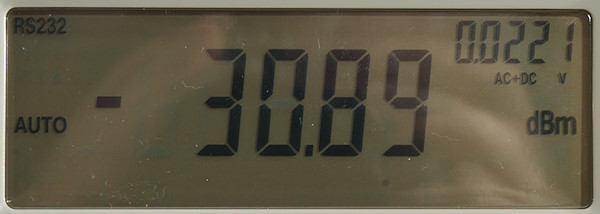
The dual display can show many different values in the different volt ranges. I have listed them below:
-
REL will use the second display to show the reference and disable the other dual display functions.
-
Max/min/Avg will use the the second display to show the value and disable the other dual display functions.
-
Dual displays in VDC: AC+DC/Hz, AC+DC/VAC, dBm/VDC, dBm/VAC, dBm/Hz, dBm/AC+DC
-
Dual displays in VAC: VAC/Hz, VAC/msLow, VAC/msHigh, VAC/%Low, VAC/%High, dBm/Hz, dBm/VAC
-
Dual displays in mV: VAC/Hz, VAC/%High, VAC/%Low, VAC/%Low, VAC/%High, dBm/Hz, dBm/VAC, dBm/VDC, dBm/AC+DC
-
Dual displays in mA & A: AC+DC/IAC, IAC/Hz
-
Dual displays in frequency: Hz/%High, Hz/%Low, Hz/msHigh, Hz/msLow
-
Dual displays in Temp mode is temperature in Celsius and Fahrenheit
Functions
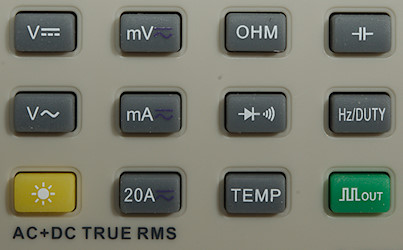
Mode buttons:
-
VDC: Select VDC mode, it is also used for AC+DC and dBm
-
mV: Select mV mode for AC and DC, it is also used for puls width and dBm.
-
Ohm: Select ohm mode, a special high ohm mode can be selected.
-
 : Select capacitance mode.
: Select capacitance mode. -
VAC: Select VAC mode, it is also used for puls width and dBm.
-
mA: Select mA mode for AC and DC, it can also show AC+DC and frequency
-
 : Select diode and continuity mode, it is the same mode and will always show voltage.
: Select diode and continuity mode, it is the same mode and will always show voltage. -
Hz/Duty: Select logical frequency mode, this will show duty cycle in secondary display.
-
 : Turn background light on, this makes the display easier to read.
: Turn background light on, this makes the display easier to read. -
20A: Select ampere range, it can also show AC+DC and frequency
-
Temp: Select temperature mode, default is internal temperature, press SELECT to use a thermocoupler.
-
 : Select square wave output.
: Select square wave output.

Function buttons:
-
Set: Used for setting limits and timer values.
-
Max/min: Select max/min/max-min/average, hold down to turn off. The value is showed in the secondary display.
-
Range: Manual range, hold down to return to auto range. Also used for impedance in dBm mode.
-
Rel: Store a reference (Shown in secondary display) and show values relative to this. Press again to store a new reference, hold down to cancel.
-
Timer: Can specify an end time to a max/min measurement (Only an alarm, will not stop the measurement).
-
Hold: Auto hold function, when input is stable the display will update and the buzzer will signal. Press again for Peak hold. Hold down to disable.
-
2nd view: Select value in secondary display. This only works when secondary display is on!
-
Select: Select function, this is AC/DC and secondary display on (Use 2nd view to change secondary display function).
-
Power: Physically turn the power on/off to the meter.
Input
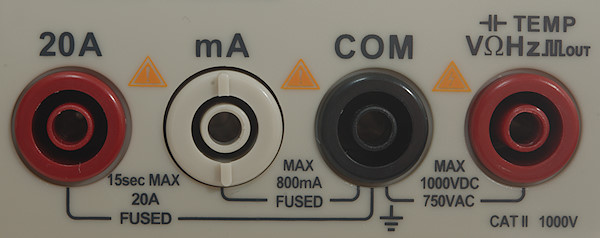
-
20A: High current, it can only withstand 20+ ampere for a short time (Fuse is 13A).
-
mAuA: The lower current ranges, fuse is in the socket and very easy to replace.
-
COM: The common terminal for all ranges.
-
xxx: All other ranges.
Measurements
-
Volt and frequency
-
Frequency counter and duty cycle do not requires a zero crossing
-
At 0.1Vrms frequency input range is from 1Hz to 5MHz
-
At 0.1Vrms frequency input range can be stretched to 0.8Hz to 8.2MHz, where it will show OL
-
1 VAC is 5% up at 120kHz
-
Duty cycle works from 20% to above 80% at 100kHz with 1Vpp, precision is within 3.4
-
Duty cycle works from 6% to above 80% at 10kHz with 2Vpp, precision is within 2.5
-
Duty cycle is slow to show the final value.
-
Max/min needs about 730ms to capture a voltage.
-
Peak hold needs about 0.6ms to capture a voltage.
-
Input impedance is 10 to 11Mohm on DC, AC has a capacitor
-
DC mV range is high impedance below 1V, then it will drop to 200Mohm up to 3.3V, above this is goes down to 10kohm.
-
AC mV range is high impedance below 3V, above this is goes down to 10kohm.
-
Maximum rated voltage is 1000VDC/AC, but no overload voltage is specified for the mV range.
-
Frequency input is around 10Mohm
-
Rated overload protection for frequency range is 250V AC/DC
-
A very audible alarm is sounded when mV or V range is overloaded
-
A “high” DC voltage on mV AC will turn the display off.
-
dBm mode default uses 600ohm, but can be selected from: 4, 8, 16, 32, 50, 75, 93, 110, 125, 135, 150, 200, 250, 300, 500, 600, 800, 900, 1000, 1200
-
-
Current
-
On the current ranges there is an audible alarm when going above range, except on 20A range!
-
mA range has a 0.5A/250V 5x20mm glass fuse (Manual says 0.8A/250V), that can easily be replace.
-
20A range has a 13A/250V 5x20mm ceramic fuse. Meter must be taken apart to replace fuse.
-
-
Ohm, Continuity, diode and capacity
-
Ohm is 1.2V open and 0.86mA shorted
-
Continuity is moderate in speed (About 50ms).
-
Continuity beeps when resistance is below 46ohm (There is some noise up to 60ohm).
-
Continuity is 4.1V open and 0.85mA shorted
-
Diode range uses 3.1V, max. display is 2.97V at 0mA, max. current is 0.85mA shorted
-
Diode and continuity is same range, it will always show voltage (Within 0.1V) and a open/shrt on the secondary display.
-
Instead of a nS range, this meter has a high ohm range
-
90uF takes about 2 seconds to measure.
-
Rated overload protection is 250V AC/DC
-
-
Miscellaneous
-
Square wave generator has the following frequencies: 0.5Hz, 1Hz, 2Hz, 10Hz, 50Hz, 60.24Hz, 74.63Hz, 100Hz, 151.5Hz, 200Hz, 303Hz, 606.1Hz, 1.25kHz, 1.666kHz, 2.5kHz, 5kHz
-
Square wave generator duty cycle can be adjusted in 1% steps, but 49% requires 98 button presses!
-
Square wave generator has about 3.8kOhm in output impedance.
-
A “high” DC voltage on temp will turn the display off.
-
Power consumption is 1.2 watt in VDC with background light off. In diode with background light on it is 2.2 watt.
-
When off the power consumption is 0 (Not all bench meters turns completely off).
-
The meter has a auto power off function, but this is disabled when RS232 is on and it is on by default. The off function will not turn the power off, only the meter circuit, the meter will use 1.3 watt in this state.
-
The meter usual need a couple of display update to reach the final value.
-
Viewing angle is fairly good.
-
Display updates around 4 times/sec
-
Bargraph updates 40 times/sec, but is fairly low resolution.
-
Backlight stays on when selected.
-
Sockets are not deep enough for standard banana plugs to be fully seated, but they will make contact.
-
Weight is 1400g without accessories.
-
Size is 248 x 205 x 88mm.
-
-
Probes
-
Probe resistance 38mOhm for one.
-
Probe wire 87cm long.
-
Aligator leads is 20mOhm for one.
-
Aligator leads wire is 12cm long
-

A look at the capacity measurement waveform.
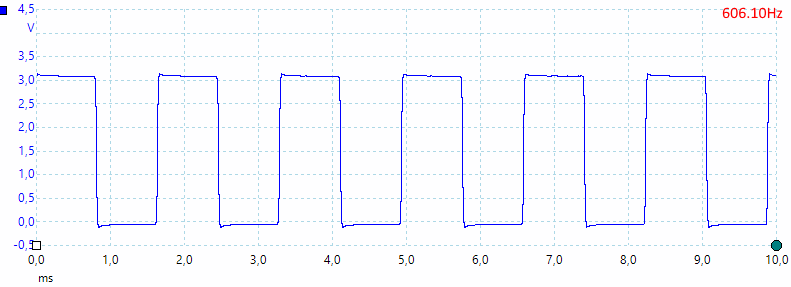
Square wave out on default setting.
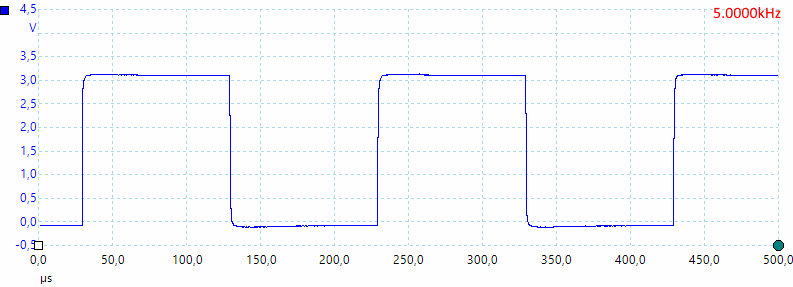
Highest frequency on generator.
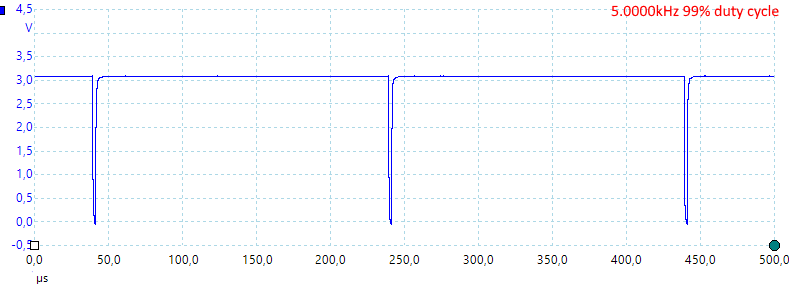
With maximum duty cycle, this required 49 presses on a button to get from 50 to 99%, there is no auto repeat or decrement button.
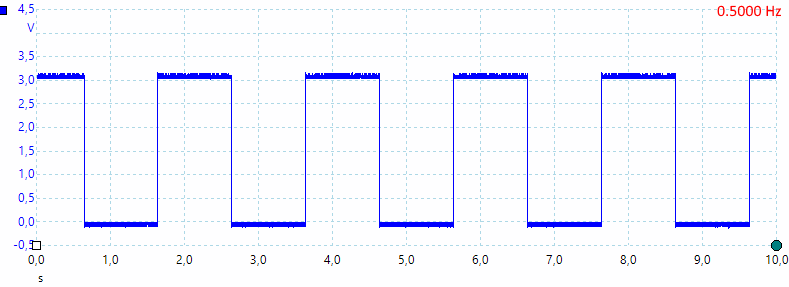
Lowest frequency.
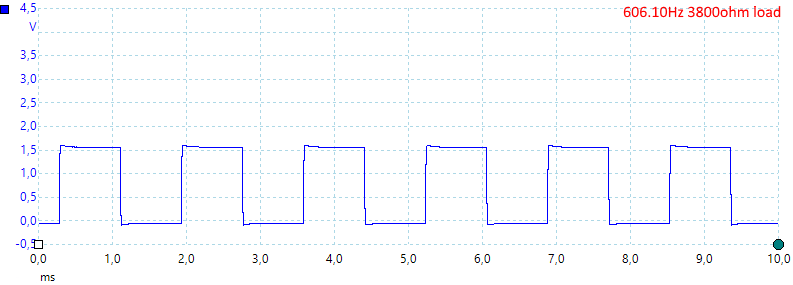
The output impedance is about 3.8kohm.

Frequency input resistance.

The AC range works best up to about 560 volt, then it looses precision according to the specifications.
Software
The software is rather old and the newest Windows it works on is XP V1, a XP simulation on Win10 do not work.
It is possible to find the protocol on the internet for people that want to write their own software.
Tear down
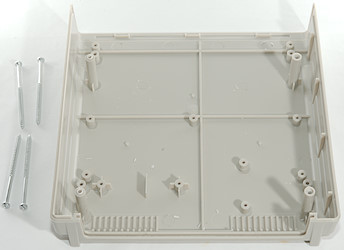
I had to remove four long screw at the bottom to open the meter, this is also required to replace the A fuse.
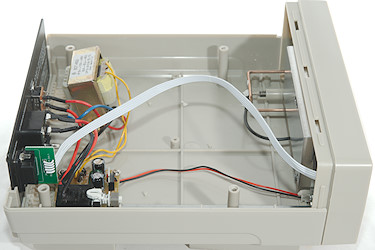
Even though the meter is small for a bench meter, there is a lot of empty space inside.
It looks like the shipping of the meter has been a bit rough (Transformer is tilting).

The power supply is a 9V DC regulator (IC10: LM7809). A significant part of the power consumption probably goes to the transformer and regulator.
The backplate has printing on both sides.
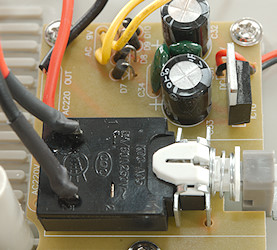
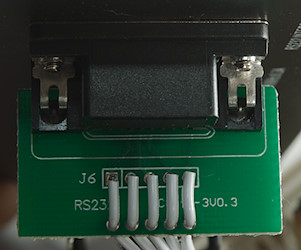
The mains switch is also on the power supply. The RS232 interface circuit board is only to connect the cables to the DB9 connector, there is no electronic on it.

The actual meter is on the front plate with two circuit boards on top of each other. The one at the back is the analog board with all the electronic hidden below a can. The 13A fuse is also here.
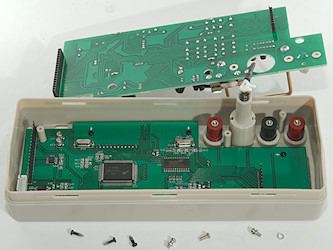
I had to remove 6 screw to get the analog board out, 3 screws was connections to the input terminals, the other 3 was to standoffs in the front plate.

And five more screws to get the digital section out.
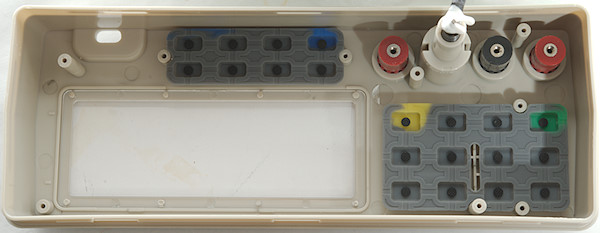
The front plate with all the buttons and terminals. The hole is for the power switch that is on a rod from the back of the meter.

The large LCD display that is soldered to the circuit board (No zebra stripe), there is two leds for the backlight (D1 & D2).
Some of the labeling is interesting with AD0..AD3, this must be address/data with only a 4 bit data bus. This is for the ADC. The K signals is for range switching and controls relays.


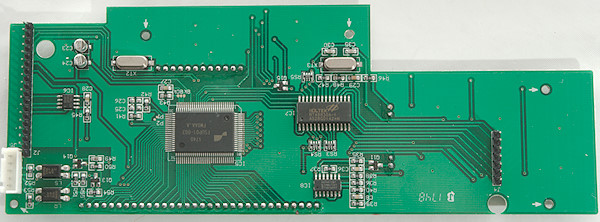
The digital board. The large chip is the LCD driver and RS232 data interface (IC5: FSUP01-003), besides it is a microprocessor (IC7: Holtek HT48R30A-1, 8bit 2kx14 program, 96 bytes ram). There is some EEPROM (IC6: Atmel 93C46 128 bytes) probably for calibration.
The RS232 interface is on the simple side, it is two optocouplers (LR & LS: COSMO 1010), because it is isolated power must be supplied by the RS232 handshake signals for the transmitter.
The datasheet for FS970x contains a typical schematic with the FSUP01 chip.

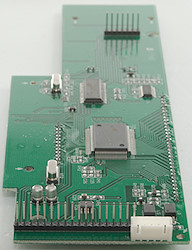
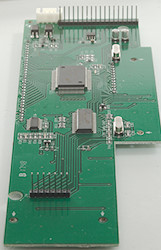

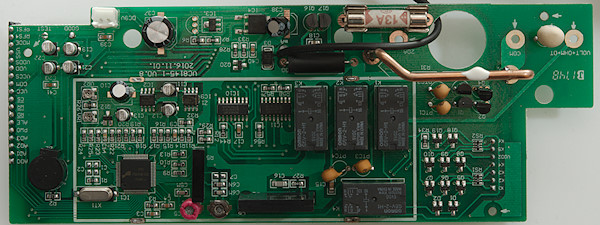
At the input is a MOV across the voltage input (Very bad idea), there is also a large A shunt (Good idea with a large shunt). The large black round resistor next to the large shunt is a mA shunt and it is protected by D3 and Q16/Q17. The input protection for other ranges is handled by some PTC’s (PTC1..PTC4) and some transistor clamps (Q1..Q4).
The analog board has the ADC (IC1: FS9704 80000 count, 4 bit interface with 8 to 24 bit registers), RMS converter (AD737J) and a reference (LM385). There is two probably custom resistors (R4 & R5: Big black boxes). There is two trimpots and two trim capacitors for some calibration.
The range selection is done with 4 relays (K1, K2, K3, K4) and some CMOS switches (IC10 & IC11: HEF4053).
There is some voltage regulation on this board, both 6V (IC3: 70L806) and 5V (IC4: 7805)
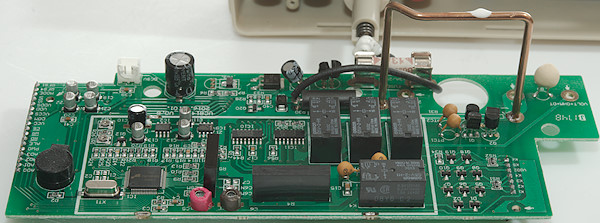
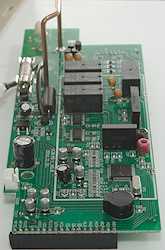
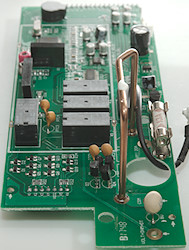

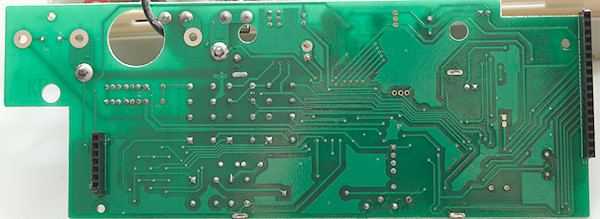

With a microprocessor with only 2k word program memory the amount of functions on this meter is fairly impressive.
Conclusion
There are a lot of details I do not like with the meter:
-
Missing overload protection on some ranges.
-
Overrange alarm will sound while the meter is auto ranging.
-
Duty cycle adjustment on square out requires way to many button presses.
-
Timer function is basically useless.
-
The capacity range only goes to 100uF
-
I am missing AC and DC at the same time.
-
Fuse is only 250V for a 1000V rated meter.
-
Combined diode and continuity
-
Min/max is fairly slow.
-
Temperature defaults to internal temperature, I want my probe temperature.
-
Some functions are blocking for each other, because they both need dual display.
-
The meter will not restart after a fast off/on cycle (It locks up), it need to be off a few seconds.
-
The user interface is not always logical.
-
Missing uA range.
But there is also a lot I like about the meter:
-
Good precision on VDC
-
Good large display when background light is on.
-
Lots of measurements.
-
The dual display is very well used.
-
It has average
-
Frequency out is at logical levels and can directly be feed to chips.
-
Peak hold is fast.
-
Auto hold.
-
True RMS and AC+DC display.
-
Cheap mA fuse, very useful on the bench with limited current and voltage.
The meter has nearly all the functions you could wish for.
Notes
How do I review a DMM
More DMM reviews

